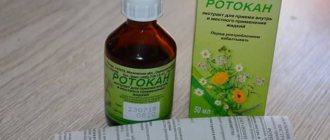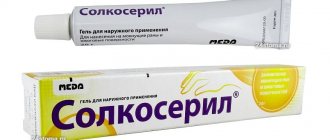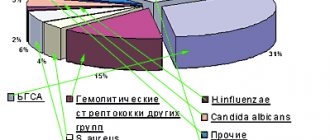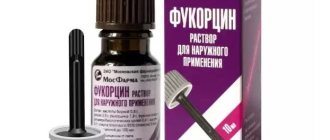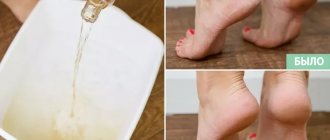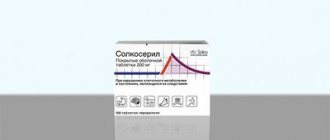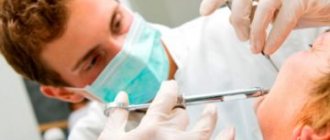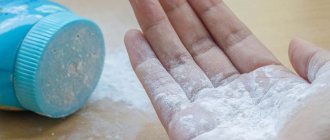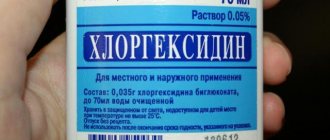What is Chlorophyllipt used for?
Chlorophyllipt in tablet form is prescribed for diseases of the upper respiratory system, as well as for stomatitis. The solution is prescribed after surgery, childbirth, or infection. Indications also include:
- pneumonia;
- pleurisy;
- gynecological pathologies;
- burn disease;
- peritonitis.
Parenteral use of the drug is effective for tuberculosis and erysipelas.
The product helps with persistent wounds and soft tissue defects.
The instructions also indicate other indications for use depending on the form of the drug.
How to gargle with Chlorophyllipt solution
The instructions for rinsing with Chlorophyllipt do not differ in any way from the standard procedure using other medications.
An important rule: rinsing should always be done with fresh solution.
- Take a small amount of the solution into your mouth: about half the size of a regular sip of water.
- Tilt your head back slightly so that your gaze is directed towards the ceiling.
- Inhale deeply through your nose.
- Open your mouth slightly.
- Make a continuous vowel sound (“i”/”ы”/”a”) for 5-7 seconds.
- Repeat steps 3-5 three times.
- Spit out the solution. If you lose your breath, recover.
- Repeat the rinse cycle (steps 1-7) 8 to 10 times.
The duration of the procedure is on average 3.5 minutes.
How to take Chlorophyllipt for children
The instructions for the drug do not contain clear recommendations regarding its use in childhood. The manufacturer claims that there is not yet sufficient experience in taking the medication in the treatment of children.
But since the drug is well tolerated by the body and rarely causes adverse reactions, it is often prescribed to children.
The oil solution can be used for colds and sore throat. They also have their nose dripped and their throat treated.
The solution can be used to treat wounds and cuts. In adolescence, it helps fight skin rashes.
How to gargle with chlorophyllipt
Most people who are prescribed the drug do not always know how to gargle with chlorophyllipt correctly and how much of this gargle is needed.
To gargle, use a 1% alcohol solution, which should be taken in the amount of one teaspoon. This dosage is calculated for one hundred milliliters of water at room temperature.
As for children, in order not to torture yourself and the child, you can use a weak spray, the concentration of which does not exceed two tenths of a percent. A stronger method is to instill an antiseptic, but it is much more effective than the previous ones.
Gargling with Chlorophyllipt should not be done on an empty stomach, that is, only at least an hour after eating food. You need to rinse for 5 minutes, do not swallow the solution.
After the procedure, you can drink and eat only after half an hour, since otherwise the solution will not be able to work. A patient with throat diseases should know that the diluted composition should be used only once, and a new one must be prepared for the next rinse.
How to use Chlorophyllipt oil solution
Often, for diseases of the larynx, an oil form of the drug is used, which does not irritate the sore throat as much as an alcohol solution. But the oil solution is not completely safe, that is, before using it for treatment, you will also need to use an allergic reaction test.
How to use oil Chlorophyllipt?
Chlorophyllipt oil can be used for the throat from childhood. As with alcohol, an allergy test is carried out in advance. Doctors recommend testing children twice before starting full treatment. Allergies can begin later and act as a cumulative effect.
Alcohol tincture acts as an aggressive irritant, oil acts more gently. After passing a test for sensitivity to the components of the drug, it is used not for rinsing, but for lubricating inflamed tonsils. Apply the substance to a tampon and apply it to the affected, inflamed parts. It is better to use disposable large cotton swabs.
Often, when the disease is complicated, rinsing with an alcohol solution and lubricating with oil are prescribed. Combine with a spray based on eucalyptus extract. The course of use of the oil preparation varies from ten days to two weeks, both combined use and alternation are possible.
Contraindications to the use of chlorophyllipt
As prescribed by a medical professional, chlorophyllipt can be used by both expectant mothers and children of school age and older.
The drug is made on the basis of plant components and is natural, therefore it is preferable to any synthetic analogues. At the same time, the natural components in the composition do not mean that allergies or intolerances to this drug do not develop. Typically, negative reactions occur when the dosage and frequency of taking the drug are violated. Among the adverse reactions:
- allergic dermatitis, skin rash, redness;
- nausea and vomiting;
- muscle spasms;
- dryness of the mucous membrane of the nasopharynx and respiratory organs.
If you are prone to allergic reactions, before using chlorophyllipt for the first time, it would not be superfluous to conduct a test for its tolerance. This can be done in the above-mentioned way, when an equally proportional solution of chlorophyllipt with water is prepared, or it can be done differently:
- dilute a small amount of 0.25% alcohol solution (about 25 drops) in a tablespoon of water;
- spray a little spray onto the inner surface of the cheek, using just one press on the spray head;
- dissolve ¼-½ tablet in your mouth.
The absence of swelling of the tissues of the lips, oral cavity, pharynx, pharynx or larynx within 6-8 hours indicates good tolerability of the drug.
Brief description of the drug
Do not be afraid to use a product of natural origin. The basis of chlorophyllipt are extracts of eucalyptus and myrtle. Take a look at the bottle with chlorophyllipt - the pleasant green color given to the solution by the mentioned plant extracts included in its composition is pleasing to the eye.
Chlorophyllipt has a complex effect, replacing the action of several drugs at once:
- destroys pathogens;
- suppresses the proliferation of microorganisms;
- reduces the formation of mucus and pus;
- stops inflammatory processes;
- stimulates tissue regeneration;
- improves blood oxygen saturation;
- stimulates the immune system.
Release forms
Chlorophyllipt has different uses, so it comes in several forms.
- Alcohol solution (concentration 1%). Designed for both indoor and outdoor use. Available in dark glass bottles with a capacity of 100 ml or 200 ml.
- Oil solution (concentration 2%). It is used externally and can be applied to mucous membranes. Packaging: 20 ml or 25 ml bottles.
- Drug for injection (concentration 0.25%). Ampoules 2 ml.
- Spray (concentration 0.2%). The drug is used to irrigate the larynx. 45 ml cans.
- Tablets in a dosage of 12.5 mg or 25 mg. Application: for diseases of the upper respiratory tract and larynx. It is recommended to dissolve. Available in combination with vitamin supplements.
To gargle a sore throat, purchase an alcohol solution of chlorophyllipt at the pharmacy.
Chlorophyllipt for rinsing during pregnancy
Colds in pregnant women, unfortunately, are more likely to develop than we would like. You can protect yourself from negative influences in every possible way, but you still get a sore throat or runny nose. Here the question arises whether it is worth using the long-tested and proven chlorophyllipt for gargling .
Manufacturers note, including in the instructions, that no clinical trials have been conducted regarding the possibility of using chlorophyllipt by expectant mothers. This does not mean that the drug is dangerous, but it does not indicate its safety either.
What should a pregnant woman know about chlorophyllipt for gargling if necessary? This is a drug based on natural ingredients. At the same time, the base is alcohol or oil. In general, there is something in the rinse solution that can cause allergies or intolerances. During pregnancy, a woman’s body is rebuilt in a very unique, individual way. It is possible that intolerance to the alcohol component or the same extract of eucalyptus or myrtle may develop precisely during pregnancy. Therefore, before starting the full use of chlorophyllipt during pregnancy, it would not be superfluous to perform a tolerance test:
- dilute the alcohol solution of chlorophyllipt with an equal amount of water;
- rinse the mouth with the resulting solution in an amount of 50 ml, no more;
- monitor the body's reaction for 8 hours; signs of an allergy may include:
- redness,
- itching,
- swelling of the tongue, lips;
Take the test and then use chlorophyllipt for treatment only after consulting a specialized specialist. Although chlorophyllipt is popular for self-medication, pregnancy is not quite a suitable period for this. Firstly, a doctor will not prescribe a drug to a woman during pregnancy in the form of tablets, an alcohol solution for oral administration, or an oil solution. Secondly, chlorophyllipt will be prescribed if suspicions of tonsillitis or pharyngitis are confirmed, and in this case the doctor will not prescribe more than gargling with chlorophyllipt diluted with water. Thirdly, this drug is not capable of having a teratogenic or toxic effect on the fetus and the woman’s body during pregnancy, but this is nothing more than an assumption, since reliable scientific studies have not been conducted. Thus, to prescribe a drug, it is necessary to take into account the duration and characteristics of pregnancy, the level of fetal development, individual sensitivity - and this is all the competence of a professional physician, sometimes not only a therapist, but also a gynecologist.
How to use alcohol Chlorophyllipt?
In pharmacies, the consumer can purchase an oil or alcohol solution. The instructions for the drugs are different, the dosage and method of administration are different. It is better to give the child oil Chlorophyllipt.
It is forbidden to dilute the product in very hot water; the temperature should not exceed 35 degrees.
If the solution is diluted incorrectly, the dosage is reduced, or poured into hot water, it will lose its properties. The product is diluted before the procedure, the liquid is stirred until smooth. Doctors give the following recommendations:
- after eating, gargle for 10 minutes;
- in the process they pronounce the sounds “e”, “s”;
- It is forbidden to swallow the drug.
Alcohol-based chlorophyllipt can cause a slight burning, tingling, tingling sensation in the throat and mouth. The effect occurs especially often when there are wounds or lesions of the mucous membrane in the mouth. If the feeling is tolerable, then contacting a specialist is not required.
It is believed that alcohol Chlorophyllipt is more aggressive and acts as an additional antiseptic, destroying bacterial infections. In fact, the effectiveness of oil and alcohol preparations is approximately the same. Differs in the manifestation of various allergic reactions. It is often successfully used by patients who are allergic to the oil preparation.
Indications for use of chlorophyllipt
The first thing that is considered an indication for the use of chlorophyllipt is the carriage of staphylococcus bacteria, including Staphylococcus aureus. Staphylococcus usually reports itself with the following diseases:
- inflammation of the larynx and tonsils - laryngitis, pharyngitis, tonsillitis;
- acute respiratory infections;
- diseases of the oral cavity - gingivitis, stomatitis and all kinds of damage to the mucous membrane, conditions after tooth extraction, etc. for the prevention or treatment of diseases of bacterial origin;
- respiratory tract diseases - pneumonia, pleurisy, bronchitis;
- damage to the skin and mucous membranes - slowly healing wounds, ulcerations, erosions.
All the diseases mentioned, in order to be susceptible to treatment with chlorophyllipt, must be united by one quality - to be of bacterial origin; chlorophyllipt is powerless against viruses. At the same time, in the case of a viral infection, chlorophyllipt will continue to perform anti-inflammatory, analgesic, antihypoxic and other actions.
Depending on the disease, the form of the drug is chosen. Chlorophyllipt is convenient because it has several forms, the effectiveness of each of which has been tested over years and decades:
- 1% alcohol solution - for internal and external use and, of course, for rinsing the mouth and throat; for inhalation using a nebulizer, this particular form of chlorophyllipt is diluted with a tenfold amount of saline;
- 2% oil solution - for external use, including coating of mucous membranes;
- 25% solution for injection - for intravenous administration for sepsis and purulent diseases of internal organs, but in ENT practice it can be used for inhalation for pharyngitis and laryngitis;
- 0.2% spray - for irrigation of the larynx;
- tablets - for resorption in the mouth, used to treat the larynx and upper respiratory tract; can be with all sorts of additives, for example, vitamin C.
As a remedy for inflammation of the mucous membrane of the larynx, tonsils, and sore throats, rinsing with a chlorophyllipt solution is often recommended.
